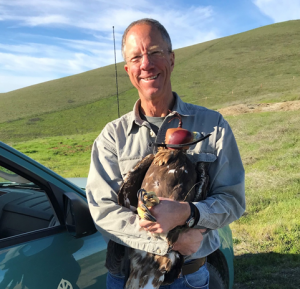 Doug Bell: In addition to his duties as the Wildlife Program Manager with the East Bay Regional Park District, Doug is an Adjunct Professor of Biology at California State University, Sacramento, and a Research Associate in the Department of Mammalogy and Ornithology at the California Academy of Sciences. Doug holds a B.A. in Zoology from Humboldt State University, a Diplom-Biologie from the University of Muenster, Germany, and Ph.D. in Zoology from U.C. Berkeley where he studied ornithology and systematic biology under Ned Johnson in the Museum of Vertebrate Zoology. He conducted Post-doctoral research on white-crowned sparrow song evolution and peregrine falcon genetics at the California Academy of Sciences. He has been engaged in a long term studies of golden eagles, prairie falcons and other raptors in California with an emphasis on assessing impacts from anthropogenic activities.
Doug Bell: In addition to his duties as the Wildlife Program Manager with the East Bay Regional Park District, Doug is an Adjunct Professor of Biology at California State University, Sacramento, and a Research Associate in the Department of Mammalogy and Ornithology at the California Academy of Sciences. Doug holds a B.A. in Zoology from Humboldt State University, a Diplom-Biologie from the University of Muenster, Germany, and Ph.D. in Zoology from U.C. Berkeley where he studied ornithology and systematic biology under Ned Johnson in the Museum of Vertebrate Zoology. He conducted Post-doctoral research on white-crowned sparrow song evolution and peregrine falcon genetics at the California Academy of Sciences. He has been engaged in a long term studies of golden eagles, prairie falcons and other raptors in California with an emphasis on assessing impacts from anthropogenic activities.
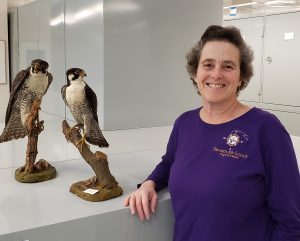 Carla Cicero: Carla Cicero is a retired Staff Curator of Birds at the UC Berkeley Museum of Vertebrate Zoology. She completed both her B.S. and PhD at Berkeley, and has worked in the museum since 1993. In addition to managing the avian collections, Carla also has trained over 120 students in curatorial practices, specimen preparation, and research. Her research program is focused on understanding species limits in birds, especially in western North America, bysahmining variation in genetic, morphological, behavioral, and ecological traits.
Carla Cicero: Carla Cicero is a retired Staff Curator of Birds at the UC Berkeley Museum of Vertebrate Zoology. She completed both her B.S. and PhD at Berkeley, and has worked in the museum since 1993. In addition to managing the avian collections, Carla also has trained over 120 students in curatorial practices, specimen preparation, and research. Her research program is focused on understanding species limits in birds, especially in western North America, bysahmining variation in genetic, morphological, behavioral, and ecological traits.
Favorite Peregrine fact: The MVZ egg collection was used to document eggshell thinning in Peregrines caused by the pesticide DDT. The fact that Peregines are now nesting on campus is a remarkable success story, and points to the importance of historical collections for documenting change and aiding in conservation efforts.
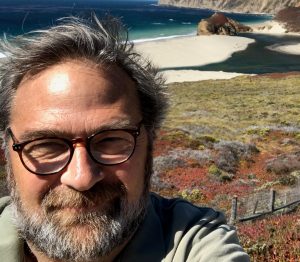 Allen Fish: Biologist Allen Fish has been on staff at the Golden Gate National Parks Conservancy since 1985 as director of the Golden Gate Raptor Observatory. GGRO is a community science program of the National Park Service created to monitor and track the west coast’s largest raptor migration site in the Marin Headlands. More than 240 amazing volunteers fuel the GGRO’s hawk counting and banding programs each year.
Allen Fish: Biologist Allen Fish has been on staff at the Golden Gate National Parks Conservancy since 1985 as director of the Golden Gate Raptor Observatory. GGRO is a community science program of the National Park Service created to monitor and track the west coast’s largest raptor migration site in the Marin Headlands. More than 240 amazing volunteers fuel the GGRO’s hawk counting and banding programs each year.
Favorite Peregrine fact: On October 19, 2008, Seattle-area raptor biologist Bud Anderson documented, using a satellite-transmitter, an adult female Peregrine flying southward on migration. Leaving the New Jersey coastline at 5 am, she flew offshore continuously for 954 miles, arriving in central Florida at 6 am the next day. That’s an average of 38 mph, through the night, all over open ocean, sometimes as much as 200 miles off the Eastern Seaboard. How one well-studied bird can change all we know about migration!
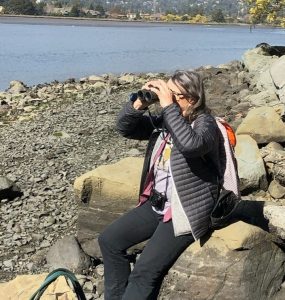
Mary Malec: I saw my first peregrine on a bridge during those last few years before there were no East Coast peregrines left. It would be 50 years before I saw my second peregrine. In the intervening years biologists used captive breeding and hacking and cross-fostering, combining science and falconry to help the peregrine recovery process. I’ve been monitoring nest sites and participating in urban fledgewatch for over 15 years, learning about this crazy and magnificent species.
Favorite Peregrine fact: There are so many different ways Peregrines communicate: with echups, chitters, wails, cakks, territorial echups, vision, speed, cliff racing, bowing and scraping, food exchanges. The ‘whitewash’ left by a peregrine on a roost or in a scrape, the ’bathtub ring’ left by hatchlings are all signs that every peregrine knows how to read and understand. With study, we can also learn to read peregrine signs and figure out what they’re saying to each other.
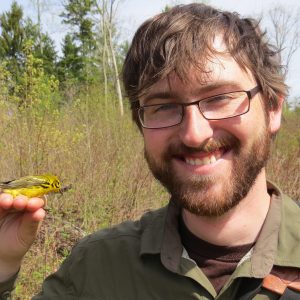 Sean Peterson: Sean Peterson received his PhD from UC Berkeley’s Department of Environmental Science, Policy, and Management, studying wetland birds in the Sierra Nevada foothills. He received his Masters Degree studying Golden-winged Warblers at the University of Minnesota. Sean has been studying birds since 2006 when he spent a summer bird banding in Costa Rica.
Sean Peterson: Sean Peterson received his PhD from UC Berkeley’s Department of Environmental Science, Policy, and Management, studying wetland birds in the Sierra Nevada foothills. He received his Masters Degree studying Golden-winged Warblers at the University of Minnesota. Sean has been studying birds since 2006 when he spent a summer bird banding in Costa Rica.
Favorite Peregrine fact: People have been hunting with Peregrine Falcons for a long time. The first known images of a Peregrine Falcon comes from Mongolia 3,000 years ago! Despite this, no species of Falcon has ever been fully domesticated.
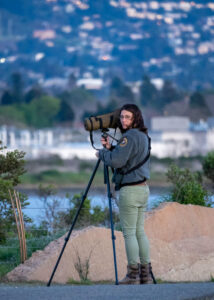 Lynn Schofield: Lynn Schofield is a biologist with The Institute for Bird Populations who currently studies wildlife responses to fire and works on wetland conservation issues in the Sierra Nevada Region. She has also been involved with the Golden Gate Raptor Observatory since 2008 as an intern and then later as a volunteer. Her research interests also include migratory behavior in neotropical birds and using novel tracking technologies to help understand bird behavior.
Lynn Schofield: Lynn Schofield is a biologist with The Institute for Bird Populations who currently studies wildlife responses to fire and works on wetland conservation issues in the Sierra Nevada Region. She has also been involved with the Golden Gate Raptor Observatory since 2008 as an intern and then later as a volunteer. Her research interests also include migratory behavior in neotropical birds and using novel tracking technologies to help understand bird behavior.
Favorite Peregrine fact:Peregrine Falcons are a highly adaptable species that can be found worldwide using a wide variety of habitats. They are just as at home hunting pigeons in your backyard as they are nesting on cliffs in the wildernesses of Greenland or Tierra del Fuego. They’ve even been seen hitching rides on boats hundreds of miles from land to hunt seabirds or migrating songbirds crossing the sea.
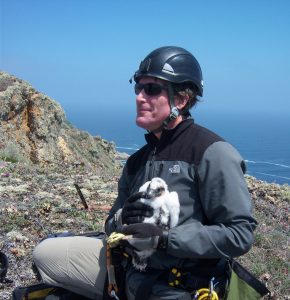 Peter Sharpe: Dr. Peter Sharpe received his Ph.D. in Zoology from Colorado State University. He has been directing the Institute for Wildlife Studies’ bald eagle restoration projects on the California Channel Islands since 1997 and peregrine falcon monitoring since 2013.
Peter Sharpe: Dr. Peter Sharpe received his Ph.D. in Zoology from Colorado State University. He has been directing the Institute for Wildlife Studies’ bald eagle restoration projects on the California Channel Islands since 1997 and peregrine falcon monitoring since 2013.
